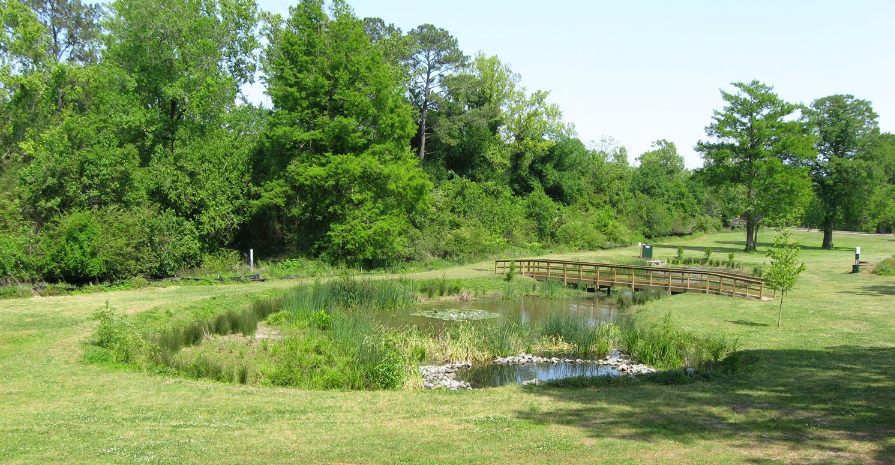We have some news on the status of the pond on the American Legion property: the Town recommends that it be turned into a constructed wetland, which would look something like this:
Wetlands are nice. They serve as wildlife habitats, protect water quality, and help prevent floods and erosion. In the engineering report about the Legion site, the benefits outlined for the constructed wetland include stormwater functionality, no flooding increase, and the ability to connect the wetland to a future trail and nature areas.
The report notes, “the constructed wetland will have a wide variety of native, non-invasive plants suited to various water depths…and provide a habitat that supports a range of wildlife including fish, insects, invertebrates, birds, mammals, and various bottomland forest plants. It will also attract beneficial insects like dragonflies and damselflies, which help control mosquito populations.”
Dam, that sounds good
The constructed wetland would also remove the town’s liability concerning the dam, which we’ve known is a problem for quite some time.
Two years ago, the Legion Property Committee wrote in their report, “The earthen dam that created the [man-made] pond is failing. The pond itself does not serve a stormwater function for most of the property….”
Last May, we learned that the dam on the Legion property is also really, really dangerous. The dam either needs to be removed or repaired pretty quickly, because it’s classified as a hazard that could result in loss of human life. The estimates for removal given at that time were $580,635 to remove the dam and $806,900 to replace the dam. This was a lowball estimate; the report notes that “cost estimates do not address any mitigation costs associated with future projects that would include impacts to the pond or stream beyond the immediate dam repair.”
And way before that, there was a months-long community discussion around what to do with the future of the Legion property. After many long meetings, the council decided this: to set 9 acres of the town-owned land aside for affordable housing and turn the rest of the 39 acres of space from Legion property and the adjoining Ephesus Park into a world-class recreational park.
The new report notes that building wetlands will accommodate “constructed wetland can be shaped to accommodate varying elevations, grades, future trails, future park and site amenities, and the Affordable Housing site.” (Building a pond, the report notes, would have constrained the site for affordable housing and would have made future amenities difficult due to grading differences.” In addition, the pond would not have removed pollutants in the same way a wetland will.
The report goes into way more detail; in addition, the town’s staff memo can be read here. If all goes well, the wetland construction would start this summer.
And just to be clear. A constructed wetland storm water control is not the same as a natural wetland. They will contain wetland plants and features. They are constructed to exhibit the same features and benefits of a natural wetland.
From the staff report:
Constructed Wetland Details:
A constructed wetland is a biologically diverse stormwater control measure that uses natural physical and biological processes to retain runoff, filter sediments and nutrients, and prevent flooding. They operate through a series of basins, open water pools, wet soils, and upland edge treatments made of densely planted native, non-invasive wetland plants and other vegetation. Unlike a static open water pond, constructed wetlands provide greater beauty, biodiversity, and a wider range of educational and recreational opportunities. The size of the constructed wetland will be designed in the next phase of the project and in conjunction with the Town’s affordable housing partner.”

